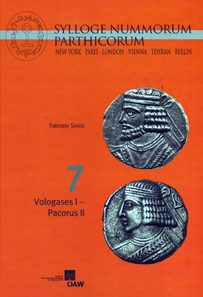by Ursula Kampmann
September 12, 2013 – From time to time I am startled to see how much remains to be done in the field of numismatics despite the over 500 years of continuous research. One of the big desiderata was to catalogue and comment the Parthian coinage according to modern methods and thus improving much on Sellwood. A new project of the Austrian Academy of the Sciences (Österreichische Akademie der Wissenschaften) is to present the Parthian coinage in nine volumes. To achieve that goal 17,000 coins were gathered from the most important coin cabinets of the world, among which the National Museum of Iran. In 2012 Fabrizio Sinisi published the first volume of the Sylloge Nummorum Parthicorum (SNP) dedicated to the coinage from Vologases I to Pacorus II, i.e. the second half of the first century CE.
By the way, it is quite remarkable that the editors of the SNP – Michael Alram, Vesta Sarkhosh Curtis and Daryoosh Akbarzadeh – decided to publish in English. It is indeed a wise decision since English has become more and more the lingua franca of numismatics.
Fabrizio Sinisi, Sylloge Nummorum Parthicorum 7: Vologases I-Pacorus II. Verlag der Österreichischen Akademie der Wissenschaften, Vienna, 2012. 431 p. with bw images, 94 pl. 21.6 x 30.3cm. Hardcover. ISBN: 978-3-7001-7206-2. 129 euros.
This book differs from the traditional principle of the Sylloge Nummorum Graecorum since it aims not only at presenting the material itself. Rather it pays equal attention to the contextualisation, the historical, numismatic and art historical interpretation. Therefore it starts with a historical overview comprising nearly 10 pages. A detailed interpretation of the images and legends follows. In some cases you must look very closely in order to distinguish the different bust types. The part focusing on the material concludes with a metrological study.
Then the author discusses the chronology of the types as defined in the previous chapters and their relation to the historical events. Those who regard this rather too complicated can consult the synchronogram that offers the types drawn in chronological order on six pages. Next, all types are listed in detailed manner and described precisely.
To most readers the catalogue will be the most interesting part. Some of them may long to return into the times of Sellwood when determining Parthian coins was an easy task. The new work, though, considers itself to be much more than a pure type catalogue. It aims at providing the researcher with as many coins as possible to accomplish their work. However, this and the numerous additional information have made the catalogue quite confusing if you simply want to determine quickly a coin. Nor the overview of the different image types and legends put at the end are of great help to that, anyway. Instead you will certainly find any die of a coin you want to determine in the 94 exuberant tables.
The user of this book is nearly buried under the mass of material offered by the author Fabrizio Sinisi. One is frightened thinking of that book to be only the first of nine volumes. Anyhow, we are looking forward to every single one of them! And we will be looking forward even more to when someone will condense all these new insights and write a new Sellwood keeping up-to-date with the research and making the auction cataloging of Parthian coinage an easy task again.
The Sylloge project is presented on the website of the Kunsthistorisches Museum …
… and on its own website.
Volume 7 is available on the publisher’s website.





